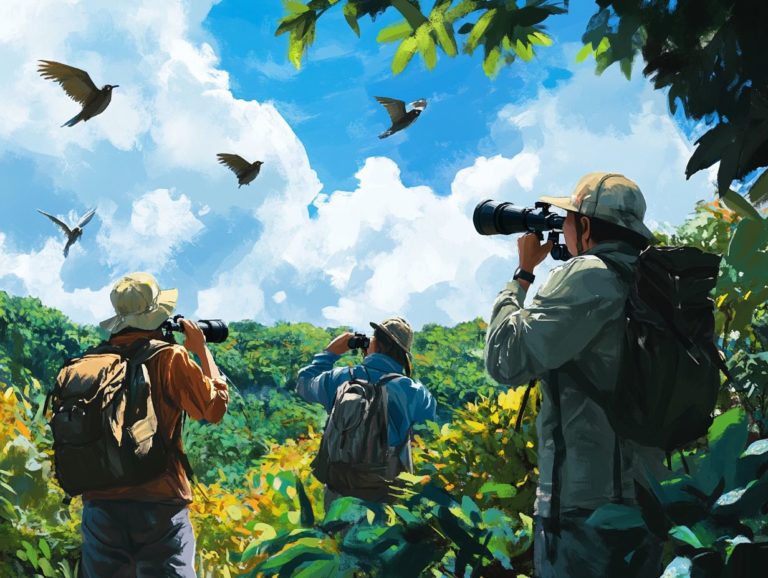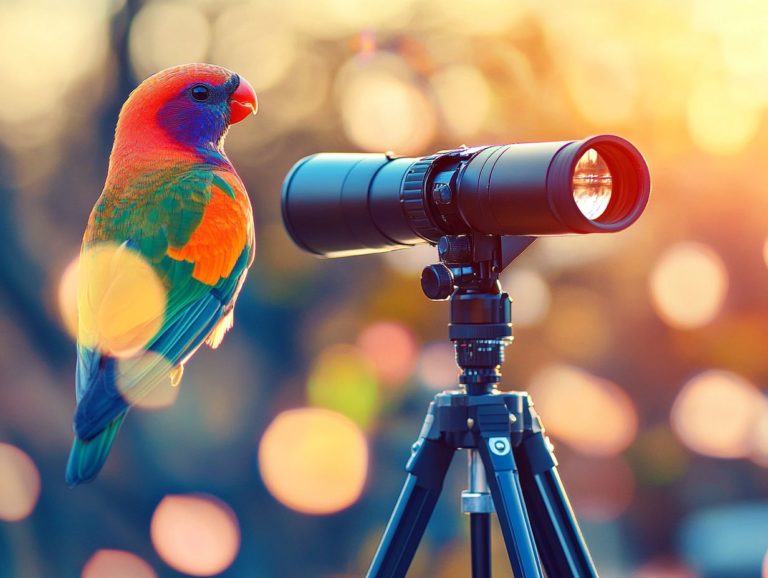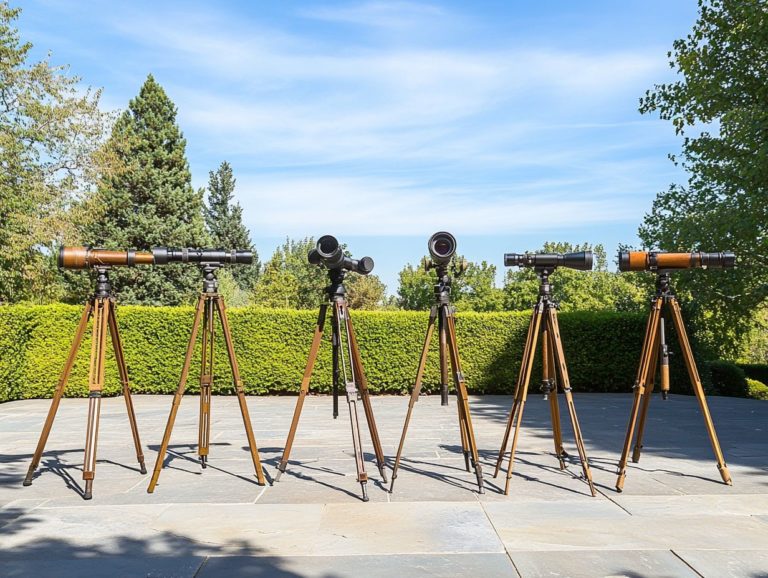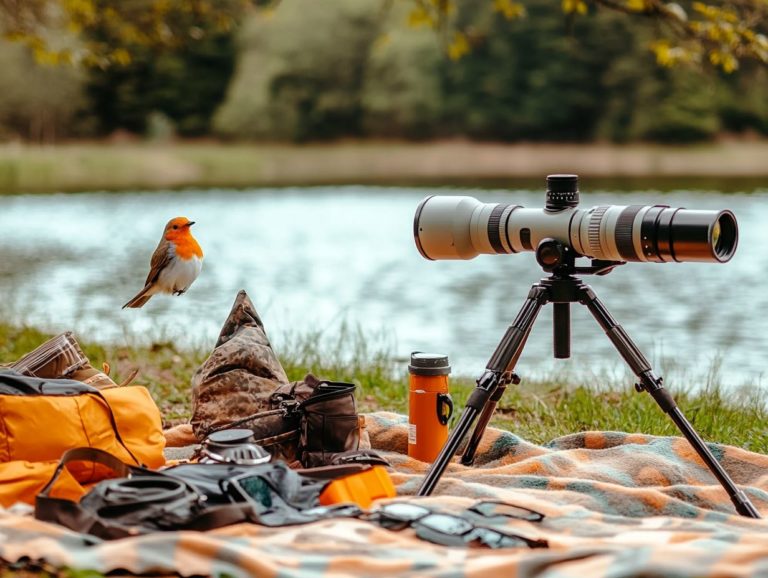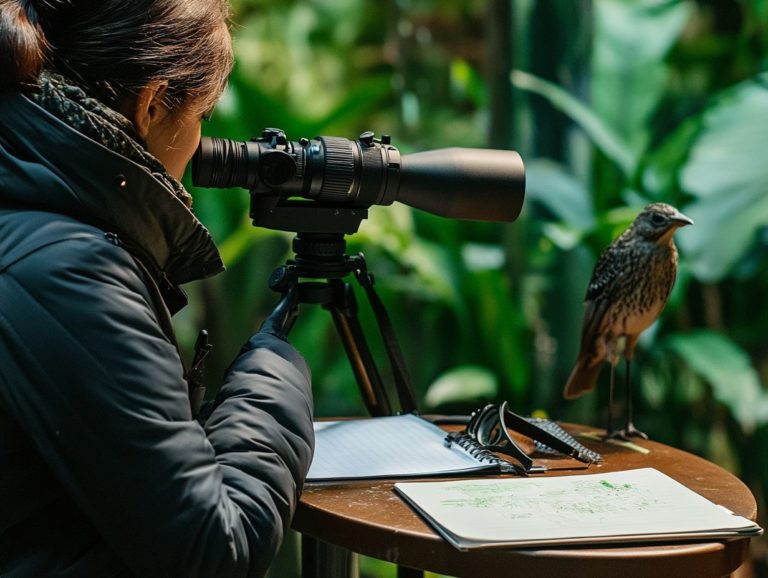How to Find the Right Spotting Scope for Your Needs
Spotting scopes are indispensable tools for birdwatchers, hunters, and nature enthusiasts. They provide exceptional visibility and detail over long distances.
This guide delves into what spotting scopes are. It highlights their essential features and diverse applications. Key considerations before making a purchase include magnification levels and durability, ensuring you choose a scope that meets your needs.
You ll find valuable tips on selecting the right scope tailored to your activities. Additionally, you will receive guidance on how to properly set up and maintain your new equipment.
Whether you re a seasoned pro or just beginning your journey, this guide empowers you to make an informed decision.
Contents
- Key Takeaways:
- Understanding Spotting Scopes
- Factors to Consider Before Buying
- Choosing the Right Spotting Scope for Your Needs
- Tips for Using and Maintaining Your Spotting Scope
- Frequently Asked Questions
- What is a spotting scope and why do I need one?
- What are the key factors to consider when choosing a spotting scope?
- What is the ideal magnification for a spotting scope?
- What is the difference between a straight and angled spotting scope?
- What type of prism is best for a spotting scope?
- Is it necessary to spend a lot of money on a spotting scope?
Key Takeaways:
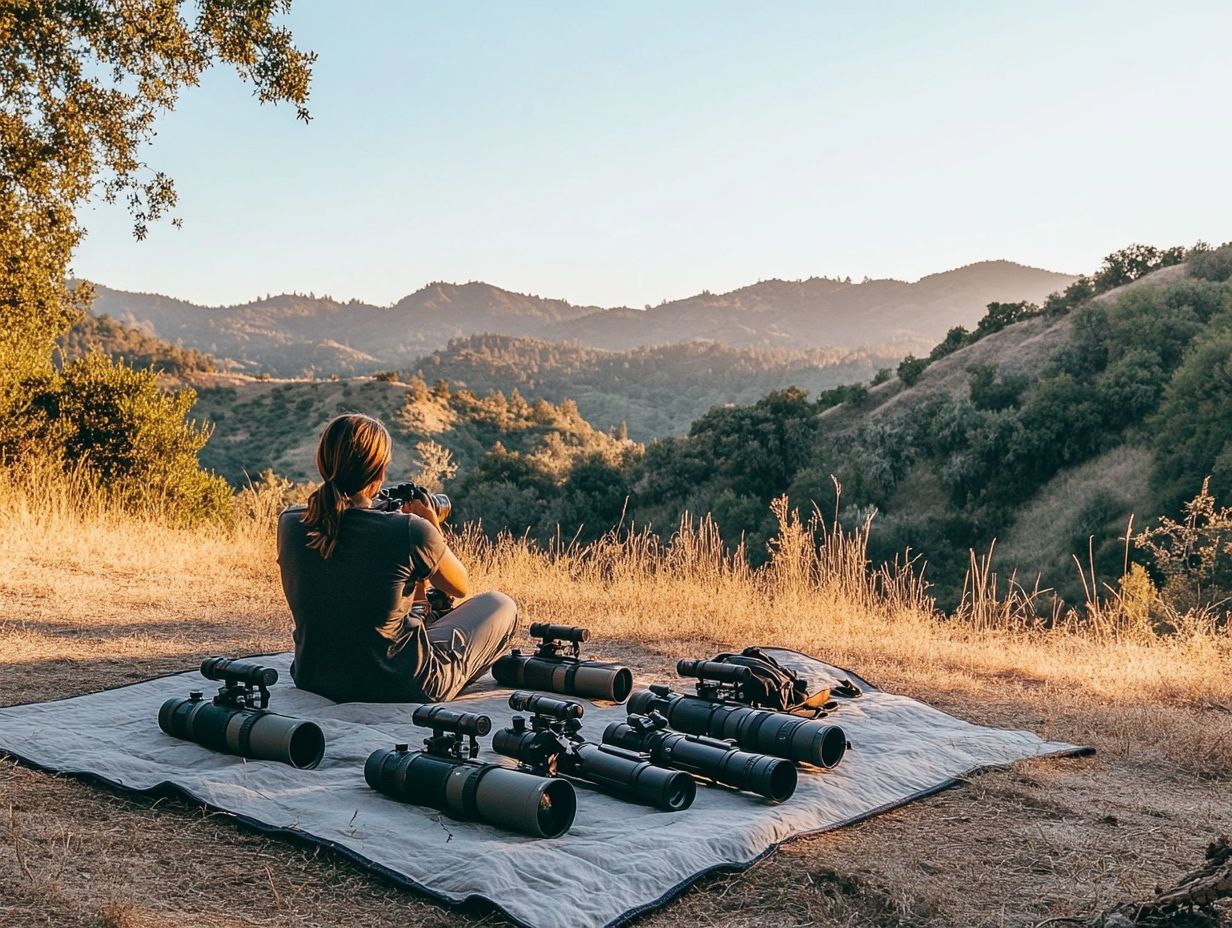
- Understand the basic features and uses of spotting scopes before purchasing.
- Consider factors such as magnification, glass elements that help focus light, and portability when choosing.
- Choose a scope that fits your specific needs and budget.
Understanding Spotting Scopes
Understanding spotting scopes is crucial for anyone engaged in outdoor pursuits. This knowledge is especially beneficial if you’re into hunting, birdwatching, or simply observing nature. To enhance your experience, learn how to make the most of your spotting scope setup.
These specialized optical devices significantly enhance your ability to see distant objects with remarkable clarity and detail. This enhancement elevates your overall outdoor experiences.
Spotting scopes feature a variety of optical systems that prioritize image quality and magnification range. This makes them essential gear for enthusiasts like you.
Selecting the right spotting scope can transform your hunting adventures or glassing distances. By considering the top features to look for in a spotting scope, you will experience improved low-light performance and an exceptional user experience, whether you find yourself in rugged terrains or exploring the backcountry.
What is a Spotting Scope?
A spotting scope is an exceptional optical device crafted for distant viewing and observation. It provides you with superior image quality and a magnification range that far surpasses standard binoculars.
This advanced equipment employs intricate optical systems. These systems feature high-quality lenses and glass elements that help focus light that collaborate seamlessly to deliver bright, clear images, even in low-light conditions.
Unlike binoculars, which generally offer lower magnification levels, a spotting scope allows you to capture intricate details from much greater distances. This makes it an essential tool for outdoor enthusiasts engaged in activities such as birdwatching, wildlife observation, or long-range shooting.
With the ability to adjust magnification, you can effortlessly zoom in on your subjects without sacrificing focus. This ensures a more immersive and detailed viewing experience.
Many of these scopes are equipped with features like waterproofing and fog-proofing. These enhancements increase usability across varying weather conditions and terrains.
Key Features and Uses
The key features of a spotting scope play a crucial role in shaping its usability and effectiveness across diverse outdoor environments. To make an informed choice, here are some important aspects to consider when buying a used spotting scope. These features are tailored to your unique preferences and hunting requirements.
By grasping these features like optical performance and premium glass quality you can significantly elevate your outdoor experience.
For example, vibrant and clear images can make all the difference when you’re observing wildlife. They allow you to spot subtle color variations and facial markings from afar.
The build quality and weather-resistant design ensure that you can rely on your scope even during unpredictable conditions. This is an essential factor for avid hunters who must maintain focus and clarity in varying light situations.
Ultimately, these features help you become more precise in the field and deepen your connection with nature.
Factors to Consider Before Buying
When you’re contemplating the purchase of a spotting scope, several essential factors demand your attention. Consider elements like magnification range, objective lens size, and low light performance. For detailed instructions, refer to our step-by-step guide for setting up your spotting scope.
Each of these aspects can significantly enhance your outdoor experiences. They also influence the results you achieve in the field.
Ready to find your perfect spotting scope? Start your search today!
Magnification and Objective Lens Size
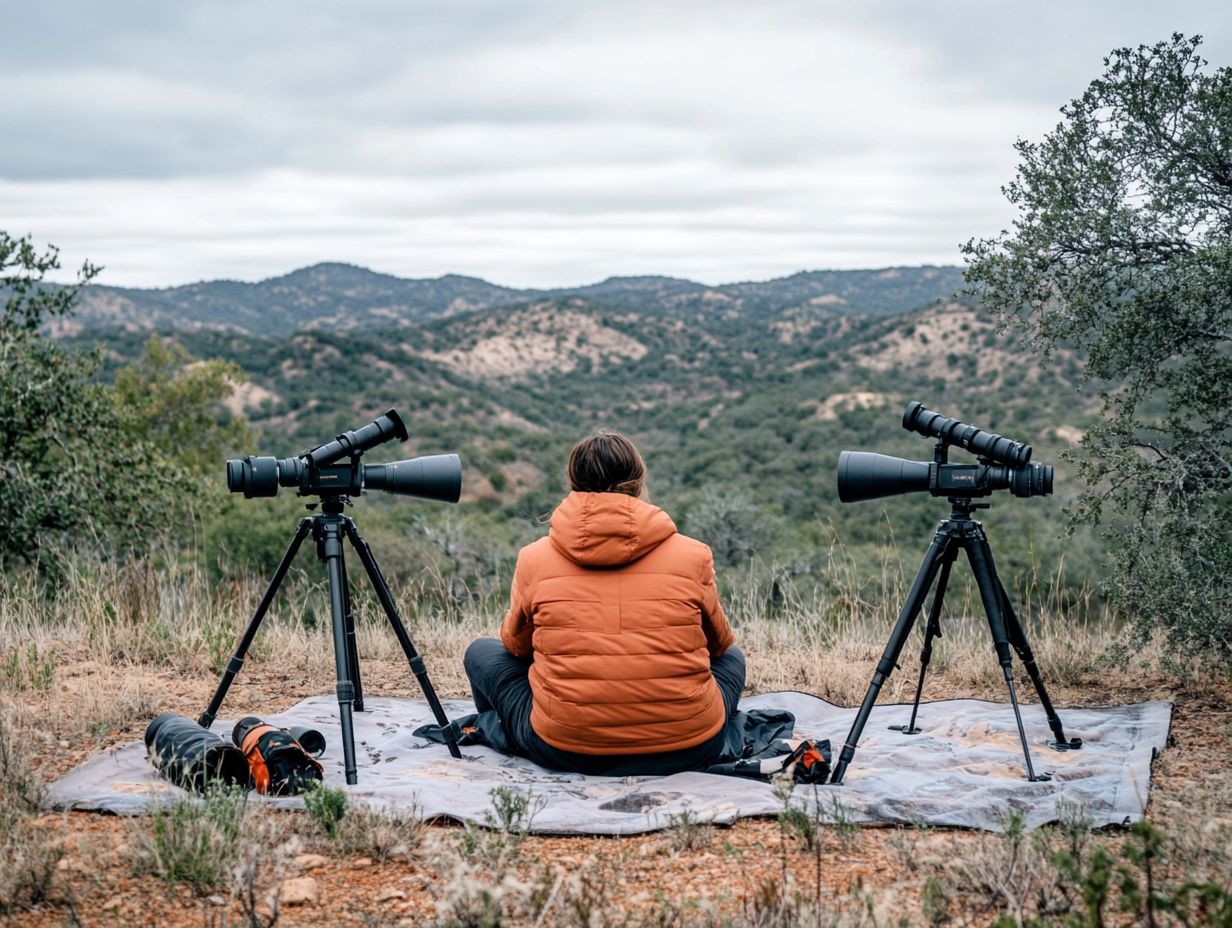
When selecting a spotting scope, pay close attention to the magnification range and objective lens size. For more detailed insights, refer to our guide on understanding spotting scopes, as these specifications are crucial for optical performance and usability.
A larger objective lens typically allows more light to enter the scope, enhancing brightness and clarity especially in low-light conditions. For example, an 80mm objective lens with a magnification range of 20-60x is ideal for wildlife observation, delivering sharp, detailed images even as dusk settles in.
If you re a hiker or birdwatcher who values portability, a compact 65mm lens with lower magnification could be your perfect match. It allows for excellent image quality without the bulk.
Understanding these specifications is essential not just for making an informed choice. This knowledge helps you enjoy optimal image clarity and resolution during your adventures whether birdwatching, hunting, or stargazing.
Types of Prisms and Lens Coatings
Understanding the types of prisms and lens coatings used in spotting scopes can enhance your decision-making process. These factors are crucial for optimal optical performance and resolution.
Different prism designs, such as Porro prisms which have a zigzag design to enhance depth perception and roof prisms, significantly impact light transmission and compactness. This, in turn, affects portability for outdoor enthusiasts like you.
Lens coatings, including anti-reflective and fully multi-coated options, enhance light clarity and minimize glare. This ensures clear observations in various lighting conditions.
Whether you’re engaged in birdwatching, wildlife observation, or stargazing, these features will greatly enhance your experience. By grasping the nuances of these components, you can confidently select a spotting scope that delivers exceptional image quality, perfectly suited for your unique outdoor adventures.
Portability and Durability
The portability and durability of a spotting scope are vital for outdoor enthusiasts like you. They influence how effortlessly you can transport your gear while ensuring it stands up to challenging conditions.
A lightweight design is essential when venturing into rugged terrains or remote locations. It allows you to transition smoothly between spots without unnecessary fatigue. Picture yourself as a birdwatcher hiking several miles through a dense forest; a compact scope that slides easily into your backpack invites spontaneous exploration while keeping comfort a priority.
Durable materials protect your equipment from harsh weather or accidental drops common hazards during a camping trip or while navigating rocky cliffs. These thoughtful features enhance your experience and guarantee that your spotting scope remains a dependable companion, no matter where your adventure takes you.
Choosing the Right Spotting Scope for Your Needs
Selecting the perfect spotting scope requires aligning your choice with your unique outdoor lifestyle, individual preferences, and specific hunting needs. For detailed insights, refer to our spotting scope buying guide. This approach will transform your outdoor experiences and ensure your equipment meets your requirements while elevating your overall experience in the field.
Target Activity and Environment
The activity you plan to pursue and the environmental conditions you face will play a crucial role in determining your ideal spotting scope. For instance, spotting scope selection: factors to consider highlight that different hunting styles and outdoor scenarios call for specific features that cater to your needs.
For example, if you re venturing into backcountry hunting, get ready for an adventure! A lightweight scope is your best friend for spotting game from a distance.
If birdwatching is your passion, you ll need a wider field of view to track those elusive fluttering creatures with greater ease.
By considering factors such as light conditions and terrain, you can further refine your selection. A scope designed for better light visibility can be a game changer during early morning or late evening outings. For more detailed techniques, refer to this guide on how to use spotting scopes for nature observation. These insights into your environment elevate your spotting experience and ensure that your chosen equipment meets your unique requirements, ultimately boosting your chances of success in the great outdoors.
Budget and Additional Features
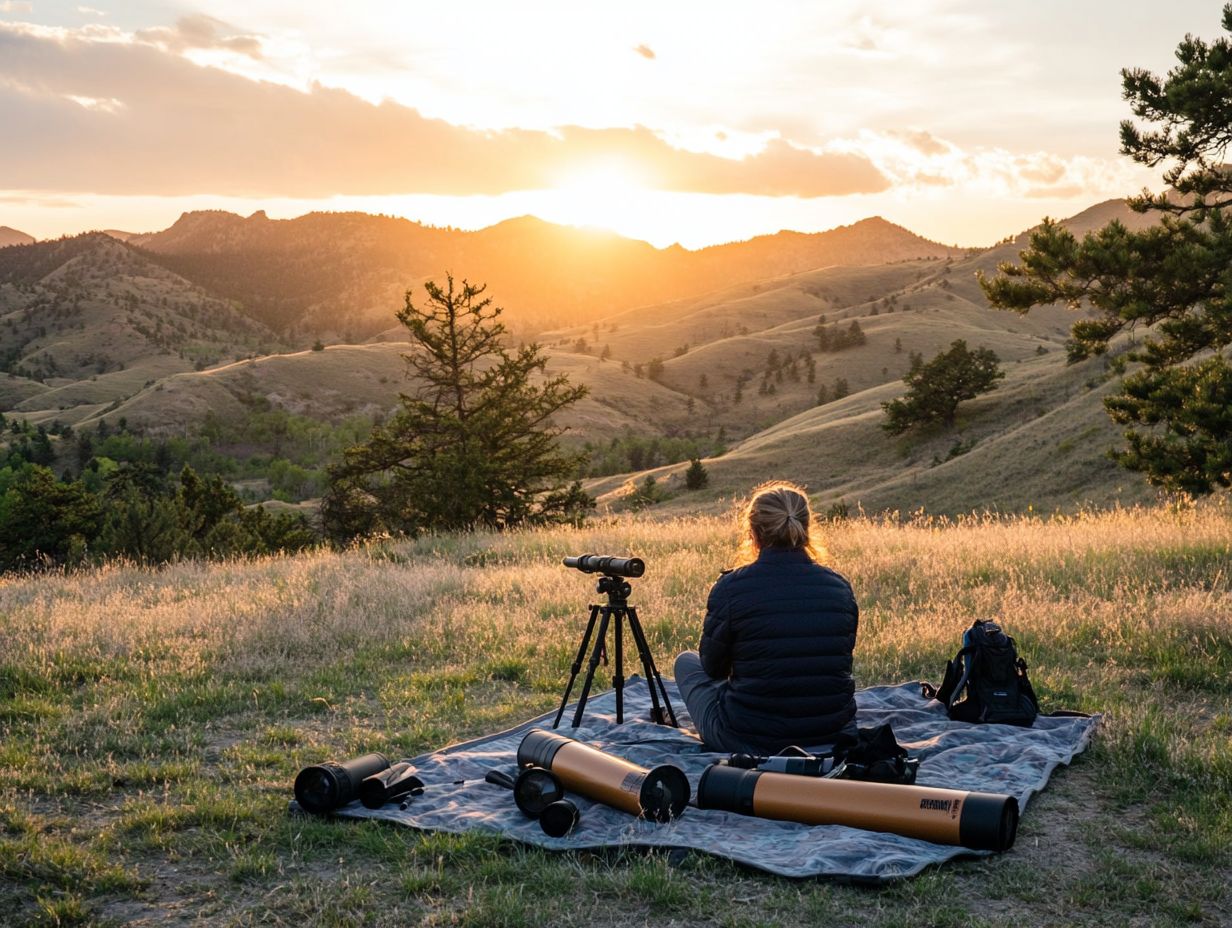
Budget considerations are paramount when selecting a spotting scope. The price-value ratio often dictates the additional features and warranty coverage available to you.
As you navigate through various price ranges, remember that a higher price tag doesn t always equate to superior quality. In fact, some mid-range models deliver exceptional optics and durability, making them perfect for casual birdwatchers or hunters.
If you re an advanced enthusiast, investing in premium scopes may elevate your experience, offering enhanced functionality like improved light visibility and advanced coatings.
It s also wise to factor in warranty coverage; a robust guarantee protects you against defects and ensures long-term value. Features such as adjustable magnification or waterproofing can significantly enhance usability. Weigh these benefits against your budget constraints to make a thoroughly informed decision.
Tips for Using and Maintaining Your Spotting Scope
Proper use and maintenance of your spotting scope are vital for ensuring its longevity and optimal performance. By taking these steps, you can enjoy clear images in a variety of outdoor settings for years to come.
Proper Set-Up and Adjustment
Setting up and adjusting your spotting scope can dramatically elevate image quality and enrich your experience especially in unpredictable outdoor conditions.
- Begin by securely attaching your spotting scope to a sturdy tripod. This solid base provides the stability you need for clearer views when observing distant subjects.
- Once it s affixed, take your time to calibrate the scope; adjusting the focus and zoom settings to suit your observation preferences is key.
- Be mindful of environmental factors windy conditions, for instance, can introduce vibrations that compromise image clarity.
Using a tripod with adjustable legs allows you to find that ideal height and angle, further enhancing your experience. Don’t forget to consider using a sunshade or cover to minimize glare and improve visibility when the sun is shining bright.
Cleaning and Storage
Regularly cleaning and properly storing your spotting scope are essential for maintaining its rugged performance and ensuring crystal-clear visuals during your outdoor adventures.
Establishing a routine cleaning schedule safeguards the lenses from dust and debris and prevents fogging and smudges that can obscure your view. Proper storage is equally crucial; keeping your scope in a cool, dry place away from direct sunlight protects its delicate components from damage.
By taking these vital steps, you can significantly enhance the optical performance and durability of your equipment. Routine maintenance like checking for loose screws and ensuring that protective caps are securely in place also contributes to a longer lifespan, ultimately making every outdoor experience more enjoyable.
Frequently Asked Questions
What is a spotting scope and why do I need one?
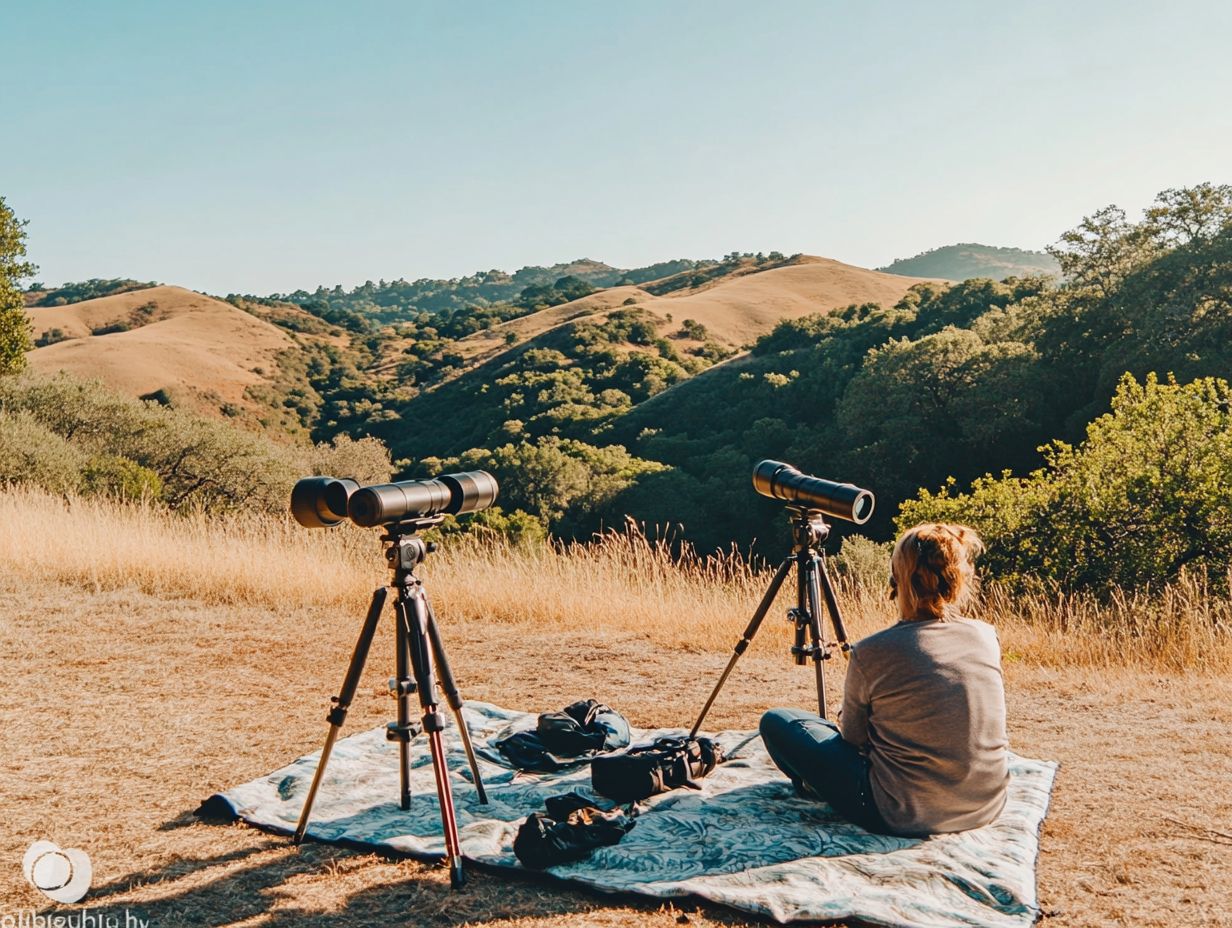
A spotting scope is a portable telescope for outdoor viewing, perfect for activities like birdwatching, hunting, and exploring nature. It provides greater magnification than binoculars, making it easier to see details up close!
What are the key factors to consider when choosing a spotting scope?
Key factors include magnification, lens size, and the scope’s weight. It s also important to consider the type of prism used, the coating on the lenses, and the scope’s durability.
What is the ideal magnification for a spotting scope?
The best magnification depends on how you plan to use the scope. For general nature observation, a magnification of 20-40x is recommended. For birdwatching or hunting, aim for 40-60x. Keep in mind that higher magnification may lead to a narrower field of view and shakier images.
What is the difference between a straight and angled spotting scope?
A straight spotting scope is easier for beginners to use because it has a straight eyepiece. An angled spotting scope features a 45-degree eyepiece, allowing for more comfortable viewing when mounted on a tripod. Your choice will depend on personal preference and intended use.
What type of prism is best for a spotting scope?
Spotting scopes typically use two types of prisms: Porro and Roof. Porro prisms are generally cheaper and provide better image quality but are bulkier. Roof prisms are more compact and durable but may have slightly lower image quality. Ultimately, your choice will depend on your budget and preferences.
Is it necessary to spend a lot of money on a spotting scope?
No, you can find a decent spotting scope at a reasonable price. Remember, a higher price usually means better quality and more features. If you’re a beginner or an occasional user, a budget-friendly option may suffice. However, for serious birdwatchers or hunters, investing in a higher-quality scope may be worth it in the long run.

